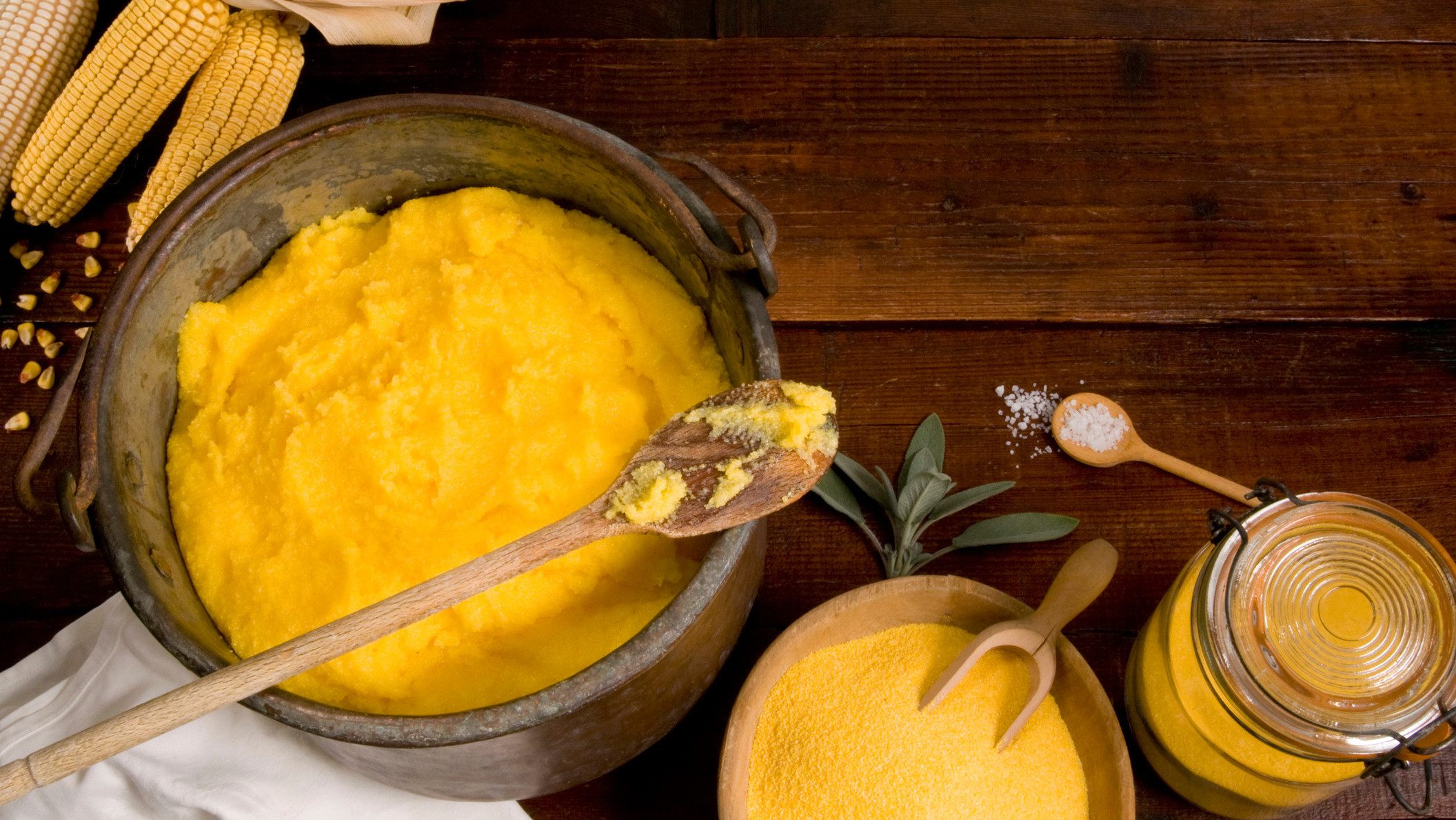Polenta's Epic Journey From Bumpkin Food To Brunch
Anytime I see a bowl of ground-up grain goo, I think of only one word: porridge. Porridge (aka gruel) is a mythical food that exists in fairy tales and story time. It's for orphans and families of bears. It's the food the prison cook thuds loudly into your bowl and then you realize, "Uh oh! Jail sure isn't going to be a walk in the park!"
Porridge made from cornmeal is known in Italian as polenta. Polenta made according to the traditional method requires finesse, patience, and constant attention just to get the desired result, which is, sadly, steamy mush. At an old job, I made it every Sunday for a year in a giant rondeau pot, and it was a masochistic affair. It's lava. It bubbles and burns, and if the heat is too high, you'll catch a cornmeal bomb on your forearm. There's never been a huge payoff with polenta. But then I realized: polenta isn't just gruel, it's an unsung hero with a turbulent past.
I first became obsessed with polenta when an ex-girlfriend gifted me a copy of Pellegrino Artusi's 1891 book Science in the Kitchen and the Art of Eating Well, considered the most significant Italian cookbook in history. Remember, Italy wasn't formally considered a country until 1861. Even then, it wasn't really unified politically. The language varied drastically from region to region. The north and south still felt like totally different countries, especially when it came to food. While southerners had a more varied diet, lots of poor northern farmers ate polenta. They ate so much polenta that the south turned it into a slur of sorts: "Because of the role played by polenta in the northern diet," Artusi wrote, "southern Italians refer to northerners as polentoni, a word that translates literally as 'big polentas' and means 'bumpkins.'"
How did this porridge, the food of the poor, get all the way to our brunch tables? Well, Artusi certainly helped. In The Art of Eating Well, he includes instructions (not recipes, mind you) for two polenta preparations: one with sweet Italian sausages and tomato paste and one with layers of bolognese and Béchamel. This wasn't some unsophisticated slop. Polenta could be a feast eaten with mushroom ragù on a giant wooden board or, in Venice, with prawns. By unifying a cuisine with his book, Artusi also had a hand in unifying the country.
Polenta still barely tasted like anything, but the polentoni had found a way to bring it up from the depths of the culinary sewers. Like all great artists, they figured out how to polish a turd. That's what polenta is all about.

Creamy Buttermilk Polenta
If you've got any kind of dairy at home, I implore you to completely ditch the water in your polenta for milk. Buttermilk in particular adds a pleasant tartness to polenta that I enjoy. Here I cut it with some heavy cream to smooth out the strong flavor. Regardless, the most important thing is that you use a 1:6 ratio for cornmeal:liquid. That is, one part cornmeal to six parts liquid. Follow this rule and you can easily make a decadent polenta that will serve as a great vehicle for any leftovers (stew, vegetables, etc.) hanging around.
- 1½ cups buttermilk
- ½ cup heavy whipping cream
- ⅓ cup cornmeal
- 1 Tbsp. salt
- ½ Tbsp. pepper
- 1 Tbsp. butter
- ¼ cup Parmigiano-Reggiano (or any cheese)
- Chives
Mix the buttermilk, heavy cream, salt, and pepper together in a small pot and slowly bring to an even simmer. Buttermilk will separate at the drop of a hat, so be sure to monitor the mixture closely while stirring gently. If you blast it with too much heat, it's going to be a mess. The fat in the heavy cream should help prevent curdling, but this is still a gradual process. Don't treat it like boiling water. Adjust heat as needed.
Once the buttermilk mixture reaches its initial boil, start to add the cornmeal in a little bit at a time and whisk hard. You've got ⅓ cup, so a few tablespoons of cornmeal at a time will be good. The rub on polenta is that you have to be whisking constantly, and while that's true, I find that such a small batch makes it easy to whisk vigorously for a few minutes then stir more gingerly for another few minutes. There really isn't a substitute for the whisking, but if you're cooking polenta for just one or two people, it certainly minimizes the amount of energy exerted. Each little bit of cornmeal you add, you want to whisk until it looks smooth and clump-less. Repeat the process every few minutes, making sure the mixture is smooth before adding more. It's very important to whisk as soon as the cornmeal touches the pot. Do this until the cornmeal is gone or you've reached a desired texture. I like my polenta rather creamy, and you might even reach that before the full ⅓ cup of cornmeal is used.
All in all, the process takes about 20 minutes. Once the polenta is creamy, toss in the butter and parmesan cheese. Fold into the polenta and serve hot with more cheese and fresh chives.
